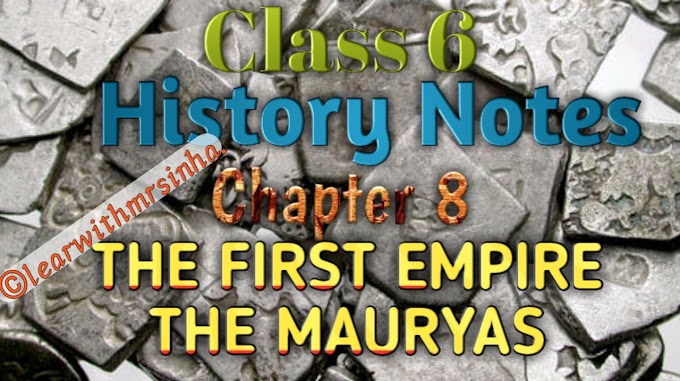History Notes
Class 6
Studying the Past
History is the study of past. History is the story of
peoples who lived in earlier time.
“History” word comes from greek word “historia”, meaning ‘learning
or knowing by enquiry’.
Class 6 Chapter 1 History Notes
Que. Why Study history?
= We study history to know the past and it is important to
understand the present.
History is divided into three time periods.
1. Prehistory
2. Proto-history
3. History
Prehistory
In this period the writing had not been invented. So there
is not any written records of this period. Our knowledge is based on archaeology.
Proto-history
This period is the time of which we have written records.
However, they are few and still cannot be read.
Ex.- Indus Valley Civilization.
Larn More
8. The First Empire - The Mauryas
11. The Gupta and Post-Gupta Period
History
The time period after the invention of writing is known as history.
S R Rao was a famous Indian archaeologist who discovered the Harappan site of Lothal and also excavated the famous dockyard there.
Time Frame of History
Dates in history are expressed in BC and AD.
BC = Before Christ
Time period before birth of Jesus Christ.
AD = Anno Domini
Time period after birth of Jesus Christ.
To find time period between two dates (both in BC or
AD) subtract the smaller date from bigger one.
To find time period between two dates (one in BC and
other in AD) add the two dates.
Sources of History
The sources is divided into two types
1. Archaeological
2. Literary
Archaeological
Source
They are direct evidences.
They are of four types :-
i.
Monuments
ii.
Inscription
iii.
Artefacts
iv. Coins
Monuments
Buildings of historical importance are called monuments. They
tell us about the period they were build, social life, religious beliefs,
culture and knowledge of science.
Ex :- Temples, Forests, Places, Stupas , Monasteries
Inscriptions
Written records engraved on rock, cave walls, metal pillars,
wall of temples and places and clay and copper tablets are called inscriptions.
Emperor Ashoka of the Mauryan Dynasty put up large number of
inscriptions.
Artefacts
The objects that human made in the past like pottery, tools,
ornaments, metal objects, jewellery and weapons are called artefacts.
Coins
They tell us about the reigning periods of kings, the
economy of the king, the extent of a king’s empire and about trade with other
regions.
Literary
Sources
They are written evidence in form of book or the peoples who
have survived to help us to know more about the past.
Manuscripts :- Handwritten records of the past, in
the form of books are called manuscripts. Usually written on palm leaves
and the bark of birch trees.
Literary sources are divided into two types:-
1. Religious
2. Secular
Religious literature
Writing which deal with religion are called religious
literature.
Ex.- The Vedas, The Ramayana, and The Mahabrata, The Gita
and the Purans.
Secular literature
Writing which are not religious are called secular
literature.
Include stories, poems, plays, biographies of kings,
accounts of foreign travellers and books on politics and science.
Ex.- The
Arthashastra by Kautilya
The
Indika by Megasthenes
The
plays and poems of Kalidas
The
Sangam literature
*****







0 Comments